Social solidarity strengthens community bonds by fostering mutual support and shared responsibility among individuals. It promotes inclusivity and cooperation, essential for creating resilient societies. Discover how social solidarity can transform your community in the rest of the article.
Table of Comparison
| Aspect | Social Solidarity | Collective Effervescence |
|---|---|---|
| Definition | Social cohesion based on shared norms and values | Intense communal energy during shared rituals or events |
| Origin | Emile Durkheim's sociology theory | Emile Durkheim's concept in sociology of religion |
| Function | Maintains societal order and integrates individuals | Strengthens group identity and emotional connection |
| Type | Mechanical and organic solidarity | Temporary, event-driven emotional state |
| Examples | Community rituals, shared laws, cultural norms | Religious ceremonies, festivals, collective celebrations |
| Impact | Long-term social unity and structure | Short-term emotional uplift and bonding |
Understanding Social Solidarity
Social solidarity refers to the bonds that unite members of a society, rooted in shared values, beliefs, and norms that foster social cohesion and cooperation. Emile Durkheim identified two forms of social solidarity: mechanical solidarity, based on similarities and collective conscience in traditional societies, and organic solidarity, arising from interdependence and specialization in modern societies. Understanding social solidarity is crucial for analyzing how social order is maintained and how individuals relate to the collective, contrasting with collective effervescence, which highlights intense communal emotional experiences during group rituals.
Defining Collective Effervescence
Collective effervescence refers to a shared emotional energy experienced during group rituals or gatherings, intensifying social bonds and reinforcing group identity. Unlike social solidarity, which denotes the structural ties and mutual dependence within a society, collective effervescence captures the dynamic, often ecstatic moments that generate a sense of unity and transcendence. Emile Durkheim introduced this concept to explain how communal rituals catalyze emotional synchrony and social cohesion.
Historical Origins of Both Concepts
Emile Durkheim introduced the concept of social solidarity in his seminal work, portraying it as the cohesion that binds individuals within societies through shared values and norms, with mechanical solidarity characterizing pre-modern societies and organic solidarity defining complex modern societies. Collective effervescence, also articulated by Durkheim, refers to the intense energy and sense of unity experienced during communal rituals or events that reinforce social bonds and collective consciousness. Both concepts originated within Durkheim's broader framework of understanding social integration and the symbolic forces sustaining societal order during the late 19th and early 20th centuries.
Key Differences Between Social Solidarity and Collective Effervescence
Social solidarity refers to the cohesive bonds that unify individuals within a society through shared norms and values, ensuring social stability and cooperation. Collective effervescence describes the intense energy and emotional unity generated during group rituals or events, temporarily enhancing social cohesion. The key difference lies in social solidarity's enduring nature as a structural foundation, while collective effervescence is a transient emotional experience that reinforces solidarity momentarily.
The Role of Rituals in Collective Effervescence
Rituals play a central role in generating collective effervescence by creating shared emotional experiences that strengthen group cohesion and reinforce social bonds. Through synchronized actions and symbolic expressions, rituals amplify a sense of unity and reinforce the collective consciousness among participants. This dynamic emotional energy distinguishes collective effervescence from social solidarity, which is more focused on structural interdependence within society.
Social Solidarity in Modern Society
Social solidarity in modern society manifests through shared norms, values, and social institutions that foster cohesion and mutual support among diverse populations. It underpins social stability by encouraging cooperation and collective responsibility in addressing common challenges such as inequality, public health, and environmental sustainability. Institutional frameworks like welfare systems, community organizations, and legal structures play crucial roles in reinforcing social solidarity, promoting inclusivity and social integration in complex urban environments.
Collective Effervescence in Contemporary Events
Collective effervescence describes the intense energy and shared emotional experience generated during large-scale social events, such as protests, concerts, and sports gatherings, which reinforce group identity and cohesion. Contemporary events like global climate strikes and social justice movements demonstrate how collective effervescence fosters solidarity by amplifying collective emotions and motivating sustained communal action. This phenomenon contrasts with social solidarity by emphasizing spontaneous emotional synchrony rather than structured social roles or norms.
Interconnections Between Solidarity and Effervescence
Social solidarity, defined by Emile Durkheim as the social cohesion binding individuals through shared values and norms, is deeply intertwined with collective effervescence, the intense communal energy experienced during group rituals or events. This dynamic interplay reinforces social bonds as collective effervescence generates emotional energy that revitalizes social solidarity, promoting unity and cooperation within a community. The cyclical reinforcement between social solidarity and collective effervescence sustains the moral fabric and collective conscience that underpin societal stability and identity.
Sociological Theories: Durkheim’s Perspective
Emile Durkheim's sociological theory contrasts social solidarity and collective effervescence by emphasizing how social cohesion arises. Social solidarity, categorized as mechanical or organic, depends on the degree of shared beliefs and division of labor that binds individuals within society. Collective effervescence represents intense communal energy during rituals or gatherings, reinforcing social norms and collective conscience, thus sustaining social cohesion.
Implications for Community Building and Social Cohesion
Social solidarity fosters community building by reinforcing shared norms, values, and responsibilities that create a sense of belonging and mutual support among members. Collective effervescence intensifies social cohesion through shared emotional experiences, generating unity and collective identity during group rituals or events. Understanding the balance between stable social structures and dynamic emotional connections is crucial for developing resilient, engaged communities.
Social Solidarity Infographic

 libterm.com
libterm.com